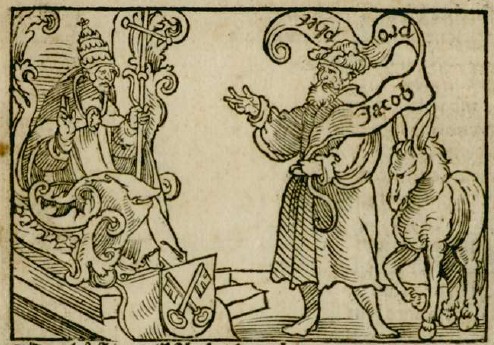mikeh wrote:It seems to me that "Taroch è diventato lo mio core" counts as a tarocchi appropriati that places Matto with Mondo (
viewtopic.php?f=11&t=1102&start=40#p17022). It is type B, 16th century. Less assuredly the Pasquinade by Aretino, 1522, places Matto in the same general group as Mondo. The Boiardo poem, while not an appropriati in the sense of using all or most of the titles of the tarot subjects, also places the two together; likewise the
Sermones does the same with similar language.
I tend to agree with Pratesi that in 'lo mio core' is a matter of literary exingency, and possibly as you say a play between 'taroch' and 'Matto' (as both meaning crazy, foolish). The Boiardo is a different sequence with a range of different names and concepts, the Sermones is clearly 21 trumps plus the fool, to make it 22 because it is placed last or in '22nd line/place', though it is separate, numbered 0 and called Nulla, could by similar reasoning make it 22 in all the appropriati poems (with the exception of the one that ends with the four papi), just because it is mentioned last or '22nd'.
The Fool of the Sermon is 'without value', no particular evidence of his being the holy fool type. That of Boiardo more of an everyman of the "Mirror of Fools" folly/vanity genre of literature so popular from the middle ages and revived by Brant and Erasmus.
Mondo, da pazzi vanamente amato,
Portarti un fol su l'asino presume,
Ché i stolti sol confidano in tuo stato.
World, you are vainly loved by the mad,
And a fool thinks he can bring you on his donkey,
Because the foolish only trust in your state.
The section with trumps is itself called 'CAPITULO DEL TRIOMPHO DEL VANO MONDO', The Triumph of the Vain World. (Vano - vain, empty, hollow, foolish, delighting in vanity and trifles).
Also, while there are 22, the introductions defines them as 21, and the fool at the most abject/vile place:
Quattro figure ha ogni color ancora,
che ai debiti suo' offici tutte loco,
con vinti et un trionfo; e al più vil loco
è un folle, poi che 'l folle el mondo adora.
Each suit also has four figures,
each of which I place in the due role,
with twenty-one triumphs; and at the most abject place
is a fool, because the fool the world adores.
Again, not so much the holy fool, as the vainglorious. Unless, perhaps, you take the fool on his donkey whom the world adores to be Christ?
Boiardo's World/Fool is not the ultimate or penulitimat triumph but occupies 'the most abject place'. It is not some Christ or Anima Mundi type figure in a divine chariot with the holy animal wheels of Ezekiel or evangelist spreading the good news over the world; nor even some holy City or ideal polity held aloft by cherubs; but a vain world delighting in trifles, full of fools whom the World adores and carried along by a Fool on a Donkey, a world in which the battle between vice and virtue takes place. I do not see any overtly or implicit narrative of salvation, there is no triumph of Eternity, we end with the Triumph of Fame (as if to say vainglory is the greatest triumph in this world of fools). So I do not see a good or convincing reason to take Boiardo's conflation of Fool and World 'in the most abject place' to justify the union of World and Fool in other tarot orders.
Our definition of 'appropriati' seems to be at variance, you seem to define it as any poems (or even listings?) that uses "all or most of the tarot subjects", I take it to mean a poem or listing that links a personage with a trump, more especially so where a description of the 'appropriateness' of the attribution is given (or as the game and records of the game as such).
mikeh wrote:
I did not realize that the Bologna appropriati were as late as the 18th century. That is when Bologna was not only under the thumb of the papacy, but in particular at least one prelate actually intervened in the tarocchi, enough so that the papi had to have black faces.
The three in the Pratesi article all mention the 4 moors, so post 1725. But I believe there is another with Ladies of Bologna which has four papi so pre-1725 (which I think I saw in another Pratesi article somewhere).
However he also has the sonnet, but not much earlier (c. 1680-1700):
Li Trionfi de’ Tarochini sopra il Techeli
Ribelle dell’Imperatore.
Angel d’inferno sei Michel, che al Mondo
Tentasti d’Austria il Sol vendere nero,
Tu la Luna Ottomana, astro che immondo,
Suscitasti fellon contro l’Impero.
Stella d’onor della Saetta il pondo,
Qual Demonio infernal scoccasti invero,
Con influsso di Morte il brando a tondo
Girasti Traditor, Vecchio severo.
La Ruota alla Fortuna arpia superba
con la Forza inchiodar speravi affatto,
Di te Giusta vendetta il Dio ti serba.
Tempra l’ardir, trattien il Carro, e ratto
Lascia d’Amor d’Imper la voglia acerba,
Ne il Papa tien qual Bagattin, o Matto.
This sonnet could be considered a type of appropriati I suppose, excepting that a place rather than a person is attributed to the cards? (i.e., The Sun of Austria, The Ottoman Moon - Folengo also interprets the Moon card as a symbol for the Turks. There is also the person Michel with the Angel, albeit a hellish one, so yes an appropriati.)


